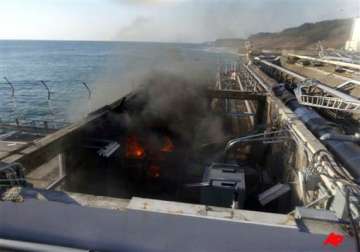Will Fukushima Explode Like Chernobyl?
Tokyo, Apr 12: As Japan raised its assessment of crippled Fukushima Daiichi nuclear power plant to the worst rating of 7 on an international scale, putting it on par with the 1986 Chernobyl explosion, the

Tokyo, Apr 12: As Japan raised its assessment of crippled Fukushima Daiichi nuclear power plant to the worst rating of 7 on an international scale, putting it on par with the 1986 Chernobyl explosion, the question arises: Will Fukushima explode like Chernobyl?
The accident at Chernobyl involved a burning graphite reactor that pushed radioactive particles high into the atmosphere and downwind across Europe.
The Japanese accident has mostly produced radioactive liquid runoff into the Pacific Ocean and low-altitude radioactive particles that have tended to blow out into the ocean and quickly fall into the water.
The New York Times reports that on the International Nuclear Event Scale, a Level 7 nuclear accident involves “widespread health and environmental effects” and the “external release of a significant fraction of the reactor core inventory.”
The scale, which was developed by the IAEA and countries that use nuclear energy, leaves it to the nuclear agency of the country where the accident occurs to calculate a rating based on complicated criteria.
Japan's previous rating of 5 placed the Fukushima accident at the same level as the Three Mile Island accident in Pennsylvania in 1979. Level 7 has been applied only to the disaster at Chernobyl, in the former Soviet Union.
“This is an admission by the Japanese government that the amount of radiation released into the environment has reached a new order of magnitude,” said Tetsuo Iguchi, a professor in the department of quantum engineering at Nagoya University.
“The fact that we have now confirmed the world's second-ever level 7 accident will have huge consequences for the global nuclear industry. It shows that current safety standards are woefully inadequate.”
Nishiyama said “tens of thousands of terabecquerels” of radiation per hour have been released from the plant. (The measurement refers to how much radioactive material was emitted, not the dose absorbed by living organisms.) The scale of the radiation leak has since dropped to under one terabecquerel per hour, the Kyodo news agency said, citing government officials.
Japan Prime Minister Naoto Kan said in a nationally televised speech on Tuesday evening to say that the reactors were being stabilized and to emphasize that radiation releases are declining.
The prime minister said he had ordered Tokyo Electric Power Company, the operator of Fukushima Daiichi, to present its plans and expectations for the stricken nuclear power plant.
He also expressed concern about the economic consequences of the accident, calling on people across Japan to continue buying products from the affected areas of northeast Japan.
Kan defended the government's record in releasing information.
“What I can say for the information I obtained — of course the government is very large so I don't have all the information — is that no information was ever suppressed or hidden after the accident,” he said.
The decision to raise the alert level to 7 from 5 on the scale amounts to an admission that the accident at the nuclear facility, brought on by the March 11 earthquake and tsunami, is likely to have substantial and long-lasting consequences for health and for the environment.
Some in the nuclear industry have been saying for weeks that the accident released large amounts of radiation, but Japanese officials had played down this possibility.
The new estimates by Japanese authorities suggest that the total amount of radioactive materials released so far is equal to about 10 percent of that released in the Chernobyl accident, said Hidehiko Nishiyama, deputy director general of Japan's nuclear regulator, the Nuclear and Industrial Safety Agency.
Nishiyama stressed that unlike at Chernobyl, where the reactor itself exploded and fire fanned the release of radioactive material, the containments at the four troubled reactors at Fukushima remained intact over all.
But at a separate news conference, an official from Tokyo Electric said, “The radiation leak has not stopped completely and our concern is that it could eventually exceed Chernobyl.”
Meanwhile, aftershocks have continued in northeastern Japan since the March 11 quake and tsunami.
The latest occurred Tuesday at 2 p.m. local time when a shock measuring magnitude 6.0 struck off the Fukushima coast at a relatively shallow depth of about six miles under the seabed, according to the USGS (US Geological Survey).
Officials at Tokyo Electric said that workers were moved to safer areas within the Fukushima Daiichi plant, but there appeared to be no damage to the power supply and no disruption to pumps sending cooling water into the plant's four most severely damaged reactors.
The aftershock appeared to be centered very close to the epicenter of a magnitude 6.6 temblor that struck the area on Monday, knocking out power to the plant for almost an hour and stopping vital cooling work.